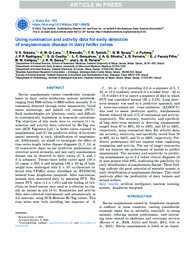Using rumination and activity data for early detection of anaplasmosis disease in dairy heifer calves.
Using rumination and activity data for early detection of anaplasmosis disease in dairy heifer calves.
Author(s): TEIXEIRA, V. A.; LANA, A. M. Q.; BRESOLIN, T.; TOMICH, T. R.; SOUZA, G. M.; FURLONG, J.; RODRIGUES, J. P. P.; COELHO, S. G.; GONÇALVES, L. C.; SILVEIRA, J. A. G.; FERREIRA, L. D.; FACURY FILHO, E. J.; CAMPOS, M. M.; DOREA, J. R. R.; PEREIRA, L. G. R.
Summary: Bovine anaplasmosis causes considerable economic losses in dairy cattle production systems worldwide, ranging from $300 million to $900 million annually. It is commonly detected through rectal temperature, blood smear microscopy, and packed cell volume (PCV). Such methodologies are laborious, costly, and difficult to systematically implement in large-scale operations. The objectives of this study were to evaluate (1) rumination and activity data collected by Hr-Tag sensors (SCR Engineers Ltd.) in heifer calves exposed to anaplasmosis; and (2) the predictive ability of recurrent neural networks in early identification of anaplasmosis. Additionally, we aimed to investigate the effect of time series length before disease diagnosis (5, 7, 10, or 12 consecutive days) on the predictive performance of recurrent neural networks, and how early anaplasmosis disease can be detected in dairy calves (5, 3, and 1 d in advance). Twenty-three heifer calves aged 119 ± 15 (mean ± SD) d and weighing 148 ± 20 kg of body weight were challenged with 2 × 107 erythrocytes infected with UFMG1 strain (GenBank no. EU676176) isolated from Anaplasma marginale. After inoculation, animals were monitored daily by assessing PCV. The lowest PCV value (14 ± 1.8%) and the finding of rickettsia on blood smears were used as a criterion to classify an animal as sick (d 0). Rumination and activity data were collected continuously and automatically at 2-h intervals, using SCR Heatime Hr-Tag collars. Two time series were built including last sequence of ?5, ?7, ?10, or ?12 d preceding d 0 or a sequence of 5, 7, 10, or 12 d randomly selected in a window from ?50 to ?15 d before d 0 to ensure a sequence of days in which PCV was considered normal (32 ± 2.4%). Long shortterm memory was used as a predictive approach, and a leave-one-animal-out cross-validation (LOAOCV) was used to assess prediction quality. Anaplasmosis disease reduced 34 and 11% of rumination and activity, respectively. The accuracy, sensitivity, and specificity of long short-term memory in detecting anaplasmosis ranged from 87 to 98%, 83 to 100%, and 83 to 100%, respectively, using rumination data. For activity data, the accuracy, sensitivity, and specificity varied from 70 to 98%, 61 to 100%, and 74 to 100%, respectively. Predictive performance did not improve when combining rumination and activity. The use of longer time-series did not improve the performance of models to predict anaplasmosis. The accuracy and sensitivity in predicting anaplasmosis up to 3 d before clinical diagnosis (d 0) were greater than 80%, confirming the possibility for early identification of Anaplasmosis disease. These findings indicate the great potential of wearable sensors in early identification of anaplasmosis diseases. This could positively affect the profitability of dairy farmers and animal welfare.
Publication year: 2022
Types of publication: Journal article
Unit: Embrapa Dairy Cattle
Observation
Some of Embrapa's publications are published as ePub files. To read them, use or download one of the following free software options to your computer or mobile device. Android: Google Play Books; IOS: iBooks; Windows and Linux: Calibre.
Access other publications
Access the Agricultural Research Database (BDPA) to consult Embrapa's full library collection and records.
Visit Embrapa Bookstore to purchase books and other publications sold by Embrapa.

